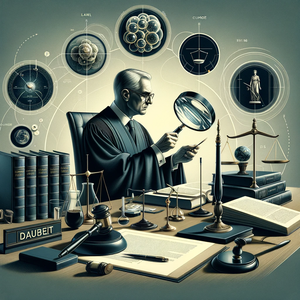Introduction
The role of an expert witness in legal proceedings is crucial, as their testimony can significantly influence the outcome of a case. The admissibility of expert testimony in federal courts is governed by the Daubert Standard, established by the Supreme Court’s decision in Daubert v. Merrell Dow Pharmaceuticals, Inc. (1993). This article aims to provide expert witnesses with a comprehensive understanding of the Daubert Standard, its criteria, and implications for their role in legal proceedings.
Historical Context
Prior to Daubert, the admissibility of expert testimony in federal courts was largely determined by the Frye Standard, which required that the methods used by the expert be “generally accepted” in their field. The Daubert ruling shifted the focus from general acceptance to a broader examination of the methodology’s reliability and relevance.
The Daubert Standard: An Overview
The Daubert Standard establishes a guide for judges to assess the admissibility of expert testimony. Under this standard, judges act as “gatekeepers” to ensure that the testimony is both reliable and relevant. The standard revolves around several key considerations:
- Testing: Can and has the theory or technique been tested?
- Peer Review and Publication: Has the theory or technique been peer-reviewed and published?
- Error Rate: What is the known or potential error rate?
- Standards and Controls: Are there standards controlling the technique’s operation?
- General Acceptance: Does the relevant scientific community generally accept the methodology?
Applying the Daubert Standard
1. Reliability
To meet the Daubert criteria for reliability, an expert’s testimony must be based on a sound scientific methodology. This means the expert’s approach should follow established steps in the hypothesis, testing, and analysis.
2. Relevance
The testimony must also be relevant to the facts of the case. This requires that the expert’s findings specifically address issues that are pertinent to the legal dispute.
Role of the Expert Witness Under Daubert
Under the Daubert Standard, expert witnesses have a heightened responsibility. They must ensure their methods are not only scientifically valid but also applicable to the specific issues of the case. This involves a careful balance between scientific rigor and legal relevance.
Challenges and Critiques
While the Daubert Standard is intended to enhance the quality of expert testimony, it also presents challenges. Critics argue that it places too much responsibility on judges, who may not have the necessary scientific expertise to evaluate complex scientific evidence properly. Moreover, the application of the standard can vary significantly between jurisdictions and even between individual judges within the same jurisdiction.
Best Practices for Expert Witnesses
To effectively navigate the Daubert Standard, expert witnesses should:
- Stay Current: Continuously update their knowledge and stay abreast of new developments in their field.
- Understand Legal Context: Be aware of how their scientific or technical expertise applies to the legal questions at hand.
- Prepare Thoroughly: Ensure that their methods and conclusions can withstand rigorous scrutiny under the Daubert criteria.
- Communicate Effectively: Be able to explain complex scientific concepts in a clear, understandable manner for a legal audience.
Conclusion
The Daubert Standard plays a pivotal role in determining the admissibility of expert testimony in federal courts. Understanding and adhering to its criteria is essential for expert witnesses. By ensuring their testimony is both scientifically sound and legally relevant, experts can effectively contribute to the judicial process and uphold the integrity of their professional and scientific responsibilities.
